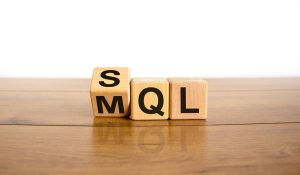
B2B enterprises work with regulatory marketing budgets. This makes it crucial for them to prefer the leads that can fetch their business a decent return on investment (ROI).
Marketing Qualified Leads (MQLs) have shown mere interest in your products and services, whereas Highly Qualified Leads (HQLs) are at the edge of making a purchase. These leads have greater potential value and are more likely to buy.
Generally, marketers put enormous efforts with B2B lead generation solutions to rope in all the available leads without striving for proper classification. As a result, they spend more time and money with very little or negligible potential leads in their hand.
Here arises the need to evaluate all leads and their buying intentions. After evaluating leads, only the best ones can be pursued. Such assessment helps to make wise decisions about pricing.
Let’s glance at the major differences between MQLs and HQLs, their respective benefits and detriments, and the deciding factors for pursuing the leads.
What is an MQL?
Generally, the first stage of qualification is a marketing-qualified lead. It is supposed to be that prospective customer who fulfills the minimal legitimate criteria to proceed with marketing and has a high chance of transitioning down the sales funnel.
When an Information Qualified Lead (IQL) believes you can solve their problems, they’ll download your brochures and offerings to learn more. That’s when you get your B2B marketing qualified leads.
After sufficient contact, MQLs can be channeled to the decision step. To encourage the lead to choose, provide as many demos, preliminaries, and free discussions as possible.
MQLs are mostly those who subscribe to newsletters, visit your website, interact with your Social Media Posts (SMPs), download information, etc.
MQL also facilitates the options of opting out or discarding the prospects that no longer remain valid or authentic. To qualify someone as MQL, evaluate their organization’s name, official email address, relevant vertical or industry, and several questions suggesting interest and concerns.
What is SQL?
The lead becomes a B2B sales-qualified lead after gathering adequate data. Due to their high value, these leads often receive tailored sales follow-ups. Since SQL constituents are not standardized, each organization can set and define its sales-qualified leads strategies. Sales leads are more interested in your products and services, so they are in the selling stage.
SQLs typically include prescribed budget data, leveraged consumer interest, client company size, employee count, and other vertical-specific data. After executing an Account-based Marketing (ABM) campaign, a new lead on the target list can also be expedited as an SQL. Before qualifying and pushing leads down the sales funnel, the marketing team must identify key differences.
The major purpose of these leads includes sales discussions, demo requests, industry research, etc. Studies showed that sales teams with faster follow-ups on B2B sales qualified leads close more. Rapid responses and inputs show leads that your organization understands them and wants to offer feasible solutions to them.
By classifying leads based on website behavior, you can ensure the sales process keeps up with the hottest leads. Lead scoring between MQL and SQL helps marketers discover and pursue significant deal-closers. Leads that fill out website contact forms, respond to emails, and register for seminars can be identified as potential SQLs.
What is HQL?
Generally, an MQL becomes SQL after passing through the qualification filters of the marketing team. But poor coordination between sales and marketing teams might lower lead quality.
Marketing teams usually only ask for prospects’ organization, designation, contact, email addresses, etc. To convert SQLs to HQLs, sales and marketing should sync and follow the Ideal Customer Profile (ICP). This is where you learn how to improve B2B lead quality.
These highly qualified leads thriving on ICP are the most qualified, decision-oriented, and have the highest buying intent. They interact with your business in several ways and help your business succeed and close more deals.
A highly qualified lead serves the Service Level Agreement (SLA) between sales and marketing. This lead meets the ICP requirements, shows the highest interest in your solutions and offerings, thoroughly answers all qualifying questions, and expresses interest in interacting with your concerned sales or marketing executive.
Also Read: Best Practices to Run a Successful HQL Sales Campaign
Outbound sales development, website chats, inbound marketing, syndication content, event leads, and outbound engagement via calls or emails typically extract HQLs.
Significant Differences between MQLs and HQLs
The difference between the B2B sales leads types exists in the caliber of sales readiness. Let’s understand the primary distinctions of MQLs vs. HQLs in B2B:
| MQLs | HQLs |
|---|---|
| They’re still looking for potential solutions to address their issues. | They’re convinced and ready to make buying decisions. |
| The leads commence contact with business inquiries. | The leads start by interacting with sales representatives. |
| They mainly express interest by subscribing to newsletters, visiting your website, interacting with your social media posts, and downloading information. | These express the highest interest in your solutions by answering qualifying questions & interacting with your concerned sales or marketing executive. |
| Identify a lead as MQL by evaluating the organization’s name, official email ID, relevant industry, & questions on interest and concerns. | Identify a lead as HQL by analyzing the prospect’s closing potential (the ease of getting converted into a sale) and revenue potential. |
| Provide as many demos, preliminaries, and free discussions as possible to persuade the lead. | Website chats, inbound marketing, content syndication, event leads, and outbound calls and emails can help generate HQLs. |
MQLs vs. HQLs: With the Respective Benefits and Detriments
Both the leads under discussion have their individual pros and cons in terms of certain parameters. The comparative analysis follows here:
| MQLs | HQLs | ||
|---|---|---|---|
| Benefits | Detriments | Benefits | Detriments |
| Found in the intermediate part of the sales funnel as has shown interest in your products and services. | Little hesitant to finalize the sales decision as has more queries. | These leads hold more potential as they’ve gone through more steps down the sales funnel. | It is often a bit challenging to make the lead reach this stage, which also incurs more costs. |
| Easier and less expensive to acquire. Most suitable for lead-nurturing campaigns and large-scale lead generation. | Requires additional efforts and push to make them sales-ready. | Requires minimal efforts at this stage to convert into customers. | Requires more resources and higher marketing expenses to generate HQLs. |
| Offer insights about prospects’ preferences and requirements to help companies understand their customers better. | The lead conversion is difficult & time-demanding in the long run so can be an expensive affair. | More beneficial in the long run as compared to MQLs, as no need for additional efforts to close the sales. | Fewer leads at the end directly indicate less business. |
| Higher lead volume indicates maximum conversion opportunities. | Companies can be hesitant to spend on data collected by marketers due to privacy issues. | The lead stands a higher chance of retaining as a customer and trustworthy advocate for your organization. | Personalizing the marketing messages for every individual lead demands more effort and time. |
MQLs vs. HQLs: Which Type of Leads to Pursue?
B2B Lead generation strategies directly influence B2B marketing expenses. Hence the below-mentioned parameters must be assessed to determine the type of leads your company should pursue:
- Latest Product Launches: Generating MQLs while launching new products enables you to nurture a larger customer base.
- Promotions: While running a product promotion, it is recommended to prefer a sync of MQLs and HQLs to leverage the advantage of burgeoning interest.
- Budget Alterations: Saving overhead costs becomes crucial when the business environment turns fierce. At this time, companies can buy HQLs and make sales personnel close them.
- Competition: When you learn that your rivals are turning aggressive in marketing, consider buying both MQLs and HQLs so that you don’t lose out on potential prospects.
- Political and Economic Aspects: Companies should remain alert about the deviations these factors may cause. They should manage the marketing strategies in response to these factors. If financial factors influence the business’s profitability, buying both MQLs and HQLs becomes feasible.
Conclusion
Comparative assessment of the leads is crucial for B2B marketing and stands significant while running the campaigns. It, therefore, becomes essential for B2B lead generation companies to coin marketing terminologies and categorize various leads according to their respective stages.
With the comparison mentioned above of HQLs & MQLs, any organization can coordinate the sales funnel and assess every lead at each stage. You can also utilize Binary Demand’s HQL services to gain a competitive edge & improve your ROI.











